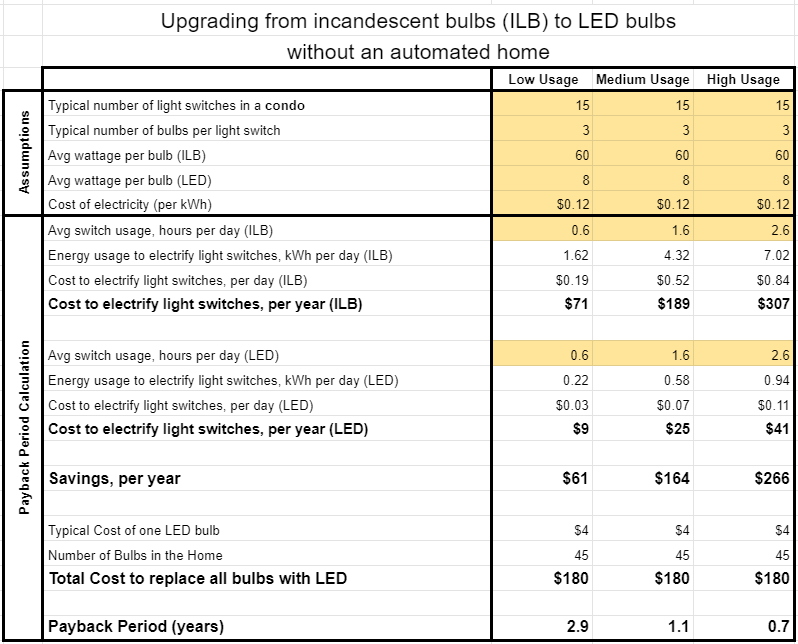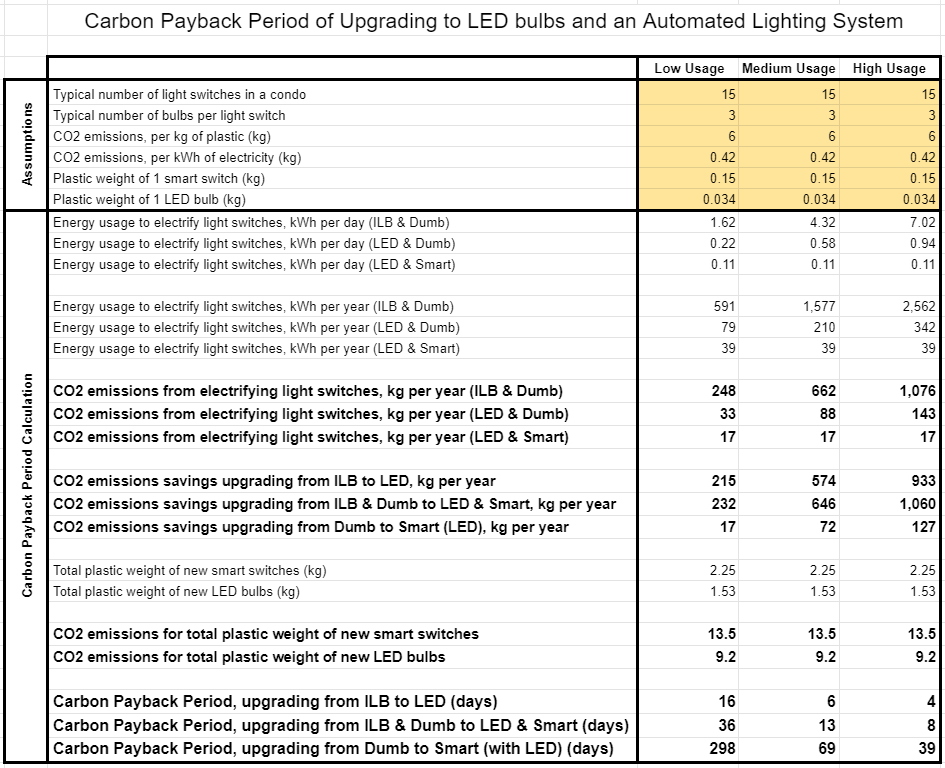At the moment in 2021, home automated lighting systems are rare. But they are quickly becoming more than just a nice-to-have. They can improve your circadian rhythm, offer some safety features like a self-monitoring security system, and even stop you from badgering your kids to turn off lights. They can also help save money. By having your lights automatically turn off when no one is around, an automated lighting system reduces energy usage. Depending on your current habits, a Piston Home system can pay for itself within 5 years.
First, let’s quickly talk bulbs. LED bulbs have finally become affordable and incredibly reliable. The biggest change a homeowner can make for their carbon footprint and electric bill is to change every bulb to LED. A 2012 US Department of Energy study estimated the typical home uses each light switch an average of 1.6 hours per day. Today, most condo homeowners can save ~$160 per year and realize a payback period of approximately 1 year with an upgrade to LED bulbs.

You can further reduce your energy consumption with an automated system. Piston Home’s automated system helps in several ways:
- For motion-activated lights, they turn off if no one is around.
- For scene-activated lights, they turn off after a preset amount of time. That means in case you forget to turn off the lights after a party, Piston Home will take care of that for you when you’re in bed.
- Every other light in the home has a built-in timer, so that they turn off after a preset amount of time, or at a specific time. For example, you can have a closet light on a 30-minute timer after it’s been turned on. Or you can schedule basement lights to turn off at 10pm every night. Or we can even do a combo: have the bedroom lights turn off every morning at 9am, AND place them on a 2-hour timer.
- Energy consumption can further be reduced with the reduction in brightness for each light switch. Most homes today only have ON/OFF (0% or 100%) switches. There are now many smart dimmers on the market that provide a full range of brightness. With Piston Home, every light switch in your home is converted to a dimmer and many automations in your home will power the bulb to just a % of its potential max brightness – dimmer in the mornings/night, and brighter in the early evenings. With LEDs, the reduction in energy consumption is roughly linearly correlated with the brightness %. Which means, if you have an LED powered to 40% brightness, it will be using ~40% of its potential electricity. This reduction is incorporated in our estimates as “Reduction of Usage due to Dimmer”.
With an automated lighting system, we’ve estimated that a typical user can reduce their average light switch usage from 1.6 hours to just 0.5 hours per day (and still live comfortably, of course!). We’ve included payback period calculations for three ranges of current energy usage (Low, Medium & High).

These estimates show that if you tend to leave your condo lights on frequently, upgrading to an automated system and LEDs could save more than $300 per year. Those savings would pay for a Piston Home in ~5 years. We’ve included estimates for a larger house as well — the payback period is consistent and remains at approximately 5 years.

CO2 Consumption
The reduction in energy consumption also means your house gets to be more green. When we first started replacing old switches with smart switches, there was so much plastic and packaging leftover from the new switches — it was a little deflating. We figured every process that went into getting these smart switches to us — resource extraction, manufacturing, packaging, shipping — had to be pretty wasteful, right? We were pleasantly surprised when we estimated our installation’s carbon payback period to be just a few months.
The carbon emissions for general plastics is ~6 kg of CO2 per 1 kg of plastic. The US Energy Information Administration notes that America’s average emissions for electricity is ~0.42 kg of CO2 per 1 kWh. Using the estimated energy savings from the previous calculations, we figure that if you install an automated home and replace your bulbs with LEDs, your carbon payback period is approximately two weeks! Even if you already have LED bulbs in your home, an automated system offsets its carbon use in just a few months. If you can’t install an automated lighting system, simply upgrading to LEDs will make you offset your carbon use in just one week.

To put this all into perspective: when you install Piston Home in your condo, approximately 14 kg of CO2 is produced — less than burning 2 gallons of gas (18 kg of CO2). Let it be known: automated lighting systems are green. Very green.
Schedule a free consultation and we’ll show you how much you’ll save with a Piston Home installation.


This Post Has 0 Comments